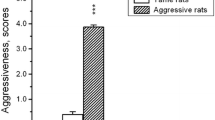Abstract
Recently, we reported on two closely related inbred mouse strains, ABG and AB//Halle, that display extreme differences in isolation-induced intermale aggression. In the present article we investigated the influence of both maternal and social postnatal environmental influences. No effects were found of the postnatal maternal environment. Likewise, whether animals after weaning were housed together in same-strain or mixed-strain groups did not influence their subsequent aggressive behavior. We conclude that the aggressive behavior of ABG and AB//Halle is rather robust with regard to postnatal environmental modification and that the difference between the two strains is most likely due to only few genetic factors.
Similar content being viewed by others
References
Bovet-Nitti, F., Oliverio, A., and Bovet, D. (1968). Effects of cross-fostering on avoidance learning and freezing behavior of DBA/2j and C3H/He inbred mice.Life Sci. 7:791–797.
Carlier, M., Nosten-Bertrand, M., and Michard-Vanhée, C. (1992). Separating genetic effects from maternal environmental effects. In Goldowitz, D., Wahlsten, D., and Wimer, R. (eds.),Techniques for the Genetic Analysis of Brain and Behavior: Focus on the Mouse, Techniques in the Behavioral and Neural Sciences, Vol. 8, Elsevier, Amsterdam, pp. 111–126.
Hahn, M. E., and Haber, S. B. (1982). The inheritance of agonistic behavior in male mice: A diallel analysis.Aggress. Behav. 8:19–38.
Maxson, S. C. (1992). Methodological issues in genetic analyses of an agonistic behavior (offense) in male mice. In Goldowitz, D., Wahlsten, D., and Wimer, R. (eds.),Techniques for the Genetic Analysis of Brain and Behavior: Focus on the Mouse, Techniques in the Behavioral and Neural Sciences, Vol. 8, Elsevier, Amsterdam, pp. 349–373.
Norusis, M. J. (1988).SPSS/PC+Advanced Statistics V2.0, SPSS Inc.
Roubertoux, P., and Carlier, M. (1988). Differences between CBA/H and NZB mice on intermale aggression. II. Maternal effects.Behav. Genet. 18:175–184.
Roubertoux, P., Nosten-Bertrand, M., and Carlier, M. (1990). Additive and interactive effects of genotype and maternal environment.Adv. Study Behav. 19:205–247.
SAS Institute Inc. (1987).SAS/STAT Guide for Personal Computers Version 6 Edition SAS Institute Inc, Cary, NC.
Schneider, R., Hoffmann, H. J., Schicknick, H., and Moutier, R. (1992). Genetic analysis of isolation-induced aggression. I. Comparison between closely related inbred mouse strains.Behav. Neural Biol. 57:198–204.
Selmanoff, M. K., Maxson, S. C., and Ginsburg, B. E. (1976). Chromosomal determinants of intermale aggressive behavior in inbred mice.Behav. Genet. 6:53–69.
Siegel, S. (1956).Nonparametric Statistics for the Behavioral Sciences, McGraw-Hill, New York.
Southwick, C. H. (1968). Effects of maternal environment on aggressive behavior of inbred mice.Commun. Behav. Biol. 1:129–132.
van Abeelen, J. H. F. (1980). Direct genetic and maternal influences on behavior and growth in two inbred mouse strains.Behav. Genet. 10:545–551.
Author information
Authors and Affiliations
Rights and permissions
About this article
Cite this article
Hoffmann, HJ., Schneider, R. & Crusio, W.E. Genetic analysis of isolation-induced aggression. II. Postnatal environmental influences in AB mice. Behav Genet 23, 391–394 (1993). https://doi.org/10.1007/BF01067441
Received:
Accepted:
Issue Date:
DOI: https://doi.org/10.1007/BF01067441




